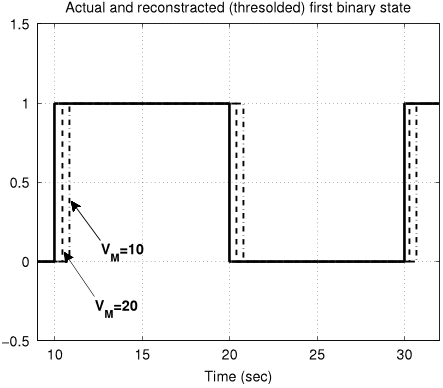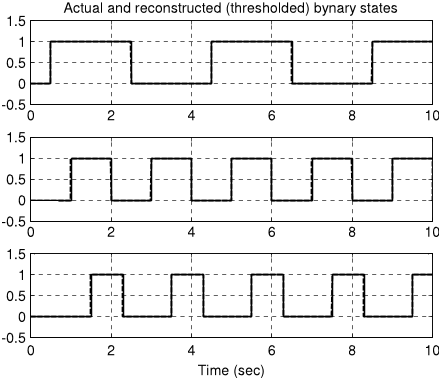Q2. What is the requirement of providing the observer convergence within the arbitrarily small transient time?
The requirement of providing the observer convergence within the arbitrarily small transient time t∗ ≪ td would correspond, in the linear context, to locating the eigenvalues of the error dynamics far away from the origin.
Q3. What is the simplest way to encode discrete states?
Note that more efficient encodings are also possible – in general with an L-dimensional binary vector it is possible to encode up to 2L discrete states – provided that each discrete state σ(t) is uniquely mapped into a binary vector δ(t), and vice versa.
Q4. What is the objective of the present work?
It is the objective of the present work to present a scheme for reconstructing the states of the three on–off valves by assuming the knowledge of the water levels and of the input inflow q(t) to the upper tank.
Q5. What is the corresponding coefficient of the generic ith valve?
Obviously when the generic ith valve is in the fully closed position, the corresponding coefficient Ci is equal to zero, vice versa if the valve is in fully opened condition Ci = C∗i .
Q6. What is the key ingredient of the proposed approach?
Key ingredients of the proposed approach are the use of a second-order sliding mode observer approach in the presence of an impulsive drift term, that as far as the authors know was never studied before, followed by a thresholding procedure that allows to exactly reject the effect of a sufficiently small uncertainty term.
Q7. What is the effect of the impulsive term ddt (t)?
The effect of the impulsive term ddt δ(t) at the switching instants ti is a jump in the (e, ė) state trajectories of system (13), and in particular, from (12), it results ‖ė‖ = ‖D(x, u, t)‖‖δ(t)‖ ≤
Q8. What is the problem with the rewrite of the system?
Then it is possible to rewrite system (13) in terms of n decoupled single input subsystems having the following form ẏi,1 = yi,2, i = 1, 2, . . . , n ẏi,2 = ϕi(x,u, t) + vi. (15)The problem is to find a set of control inputs vi stabilizing the uncertain SISO systems (15) in finite time.
Q9. What is the simplest way to reconstruct the discrete state?
In thiswork, the authors address the preliminary step of reconstructing the discrete state by assuming themeasurement for the full continuous state vector, and the generalization to the output-feedback case, which is not trivial, calls for future investigations.
Q10. What is the simplest representation of the outflow coefficients of the three-tank system?
A possible realization for σ(t) could be as followsσ(t) = δ1(t) · 22 + δ2(t) · 21 + δ3(t) · 20. (42)In the derived three-tank system the dimension L of vector δ(t) is L = 3 which does not exceed the dimension n = 3 of the continuous state, as required in assumption (2).
Q11. What is the architecture of a hybrid observer?
In [18] the architecture of a hybrid observer consisting of both a discrete and a continuous state identification part is presented and it is shown that under certain assumptions the discrete state of the system is identified in a finite number of steps.
Q12. What is the effect of the linear observer on the robustness of the observed system?
this strongly deteriorates the robustness against the measurement noise of the resulting linear ‘‘high gain’’ observer.
Q13. what is the effectiveness of the suggested discrete state observer?
It is worth noting that the discrete state σ(t) ∈ {0, 1, . . . , 7} can be reconstructed from the thresholded estimates δ̂1(t), δ̂2(t), δ̂3(t), according to (42), by means of the following expressionσ̂ (t) = δ̂1(t) · 22 + δ̂2(t) · 21 + δ̂3(t) · 20. (44)The effectiveness of the suggested discrete state observer is now studied bymeans of some simulative analysis conducted on the three-tankmodel (36)–(38).
Q14. What is the simplest way to infer that yi,2 undergoes ?
At t = t1, when the yi,1 and yi,2 variables are both assumed zero, on the basis of (17), the authors can infer that yi,2 undergoes a jump that, for the worst case, leads the system states (yi,1(t+1 ), yi,2(t + 1 )) in the point (0,D0).












